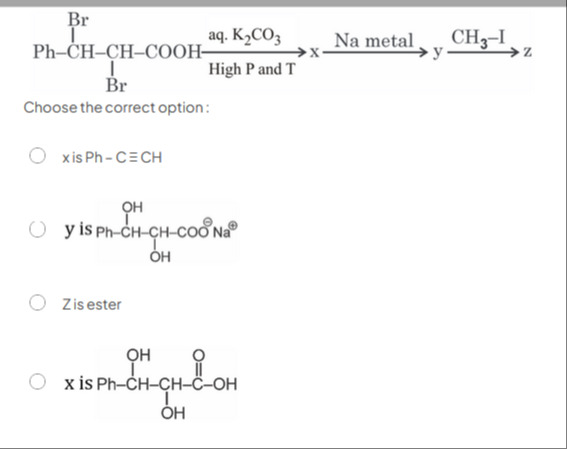Question
Question: ```tex \begin{aligned} \begin{array}{cccc} & \text{Br} & & \\ \text{Ph}-\text{CH}-\text{CH}-\text{C...
\begin{aligned} \begin{array}{cccc} & \text{Br} & & \\ \text{Ph}-\text{CH}-\text{CH}-\text{COOH} & \xrightarrow[\text{High P and T}]{\text{aq. }K_2CO_3} & \text{x} \xrightarrow{\text{Na metal}} \text{y} \xrightarrow{\text{CH}_3\text{-I}} \text{z} \\ &\text{Br} & & \end{array} \end{aligned}
Choose the correct option:

x is Ph-C≡CH
y is Ph-CH-CH-COO Na
OH
Z is ester
x is Ph-CH-CH-C-OH
OH
x is Ph-C≡CH
Solution
The starting material is 2,3-dibromo-3-phenylpropanoic acid. The first step is reaction with aqueous K2CO3 under high pressure and temperature. Aqueous K2CO3 is a basic solution. Under high temperature and pressure, elimination of HBr can occur, followed by decarboxylation.
Starting material: Ph-CH(Br)-CH(Br)-COOH.
Elimination of two molecules of HBr can lead to phenylpropiolic acid:
Ph-CH(Br)-CH(Br)-COOH Base Ph-C≡C-COOH
With aqueous K2CO3 at high temperature and pressure, it is possible that double dehydrobromination occurs to form phenylpropiolic acid, which then undergoes decarboxylation under the same conditions (heating a carboxylic acid with a base can cause decarboxylation, especially if the resulting carbanion is stabilized, although in this case the carbanion from decarboxylation of phenylpropiolic acid, Ph-C≡C−, is stabilized by the triple bond).
So, a possible product for x is phenylacetylene:
Ph-C≡C-COOH Heat, Base Ph-C≡CH + CO2.
Therefore, x could be Ph-C≡CH.
The next step is reaction of x with Na metal to form y. If x is Ph-C≡CH, which is a terminal alkyne, it has an acidic hydrogen. Reaction with Na metal will form the sodium acetylide:
Ph-C≡CH + Na → Ph-C≡C− Na+ + 1/2 H2.
So, y is Ph-C≡C− Na+.
The final step is reaction of y with CH3-I to form z. Sodium acetylide is a nucleophile and reacts with methyl iodide in an SN2 reaction:
Ph-C≡C− Na+ + CH3-I → Ph-C≡C-CH3 + NaI.
So, z is phenylpropyne (1-phenylprop-1-yne).
